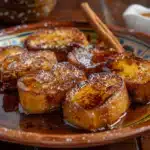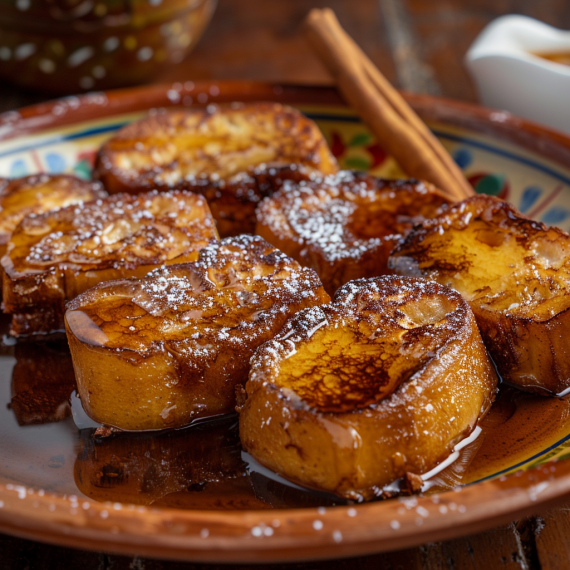Waking Up to Tradition and Flavor
Imagine the comforting scent of cinnamon, caramel, and fried bread filling your home on a quiet Sunday morning. These aromas often remind many of their abuela’s kitchen, where love was baked into every bite. Torrejas, also known as Mexican French Toast, are more than just a breakfast dish; they are a slice of tradition, a culinary heirloom passed down through generations.
If you’re looking to recreate this nostalgic experience or discover a new twist on classic French toast, this authentic Torrejas recipe is just what you need. In this guide, you’ll find everything from ingredients and step-by-step instructions to expert tips and variations to suit your taste.
What Are Torrejas (Mexican French Toast)?
A Taste of History
Torrejas have deep roots in Mexican and Spanish cuisine. Traditionally served during Lent and festive holidays like Christmas, this dish combines simple ingredients to create an explosion of flavor. The practice of soaking stale bread in a rich egg mixture and frying it dates back centuries. While similar to French toast, torrejas are unique because they are soaked in a sweet piloncillo syrup that gives them a distinct, caramelized flavor.
How Are Torrejas Different from French Toast?
- Syrup: Instead of maple syrup, torrejas are soaked in a homemade syrup made with piloncillo (unrefined cane sugar) and cinnamon.
- Texture: Torrejas are typically fried rather than griddled, making them crispier on the outside while still soft inside.
- Flavor: The combination of cinnamon, piloncillo, and sometimes orange zest gives torrejas a unique depth of flavor.
Ingredients for Torrejas
What You’ll Need
| Ingredient | Quantity | Notes |
|---|---|---|
| Bread (bolillo or baguette) | 4 thick slices | Stale bread works best |
| Eggs | 2 large | For coating the bread |
| Milk | 1 cup | Adds richness to the mixture |
| Cinnamon sticks | 2 | For flavoring the syrup |
| Piloncillo (or brown sugar) | 1 cup | For authentic caramel flavor |
| Water | 2 cups | For making the syrup |
| Orange zest | 1 teaspoon | Optional, for a citrus twist |
| Vegetable oil | For frying | Enough to fry the bread |
Step-by-Step Guide to Making Torrejas
Let’s walk through the process of making this delicious Mexican French toast. Follow these steps closely, and you’ll have perfect torrejas every time.
Step 1: Make the Piloncillo Syrup
- Combine Ingredients:
In a medium saucepan, add 2 cups of water, 1 cup of piloncillo (or brown sugar), 2 cinnamon sticks, and 1 teaspoon of orange zest (if using). - Simmer:
Bring the mixture to a gentle boil. Reduce the heat and let it simmer for about 15 minutes until the piloncillo is fully melted and the syrup thickens slightly. - Strain and Set Aside:
Remove the cinnamon sticks and strain the syrup into a bowl. Set aside to cool slightly.
Step 2: Prepare the Bread
- Slice the Bread:
Cut the bolillo or baguette into thick slices, about 1 inch each. Stale bread works best because it holds up better during soaking and frying. - Mix the Batter:
In a large bowl, whisk together 2 eggs and 1 cup of milk. You can add a pinch of cinnamon for extra flavor.
Step 3: Fry the Bread
- Heat Oil:
In a large skillet, heat enough vegetable oil to cover the bottom of the pan over medium heat. - Dip and Fry:
Dip each slice of bread into the egg and milk mixture, making sure it’s fully coated. Fry the slices in batches until golden brown on both sides (about 2-3 minutes per side). - Drain:
Remove the fried bread and place it on a paper towel-lined plate to drain any excess oil.
Step 4: Soak in Syrup
- Coat the Bread:
While the bread is still warm, dip each slice into the piloncillo syrup. Let it soak for a few seconds to absorb the rich, sweet flavors. - Serve:
Place the soaked slices on a serving plate. Drizzle with extra syrup if desired.
Tips for Perfect Torrejas Every Time
- Use Stale Bread: Fresh bread can fall apart when soaked. Stale bread holds its shape better and absorbs the syrup perfectly.
- Don’t Over-Soak: When dipping the bread in the egg mixture, make sure it’s coated but not soggy.
- Temperature Control: Fry the bread on medium heat to ensure a crispy exterior and a soft, fluffy interior.
- Flavor Enhancements: Add a splash of vanilla extract to the egg mixture for extra depth of flavor.
Variations and Serving Suggestions
Delicious Variations
- Vanilla Twist: Add 1 teaspoon of vanilla extract to the egg mixture for a warm, sweet flavor.
- Fruit Toppings: Serve with fresh strawberries, bananas, or a sprinkle of dried raisins.
- Savory Torrejas: Skip the syrup and serve with a dusting of powdered sugar and cinnamon for a less sweet option.
Serving Ideas
- Classic Breakfast: Serve torrejas with a cup of Mexican hot chocolate or café de olla for a traditional experience.
- Brunch Spread: Pair with scrambled eggs, chorizo, and fresh fruit for a satisfying brunch.
- Dessert Treat: Serve with a dollop of whipped cream or a scoop of vanilla ice cream.
Nutritional Information
Per Serving (Approximate Values)
| Nutrient | Amount |
|---|---|
| Calories | 350 kcal |
| Protein | 8g |
| Carbohydrates | 45g |
| Fat | 15g |
| Fiber | 2g |
| Sugar | 20g |
Frequently Asked Questions (FAQs)
1. What is the Difference Between Torrejas and French Toast?
Torrejas are soaked in a homemade piloncillo syrup and often fried instead of griddled. This gives them a unique texture and a rich, caramelized flavor compared to traditional French toast.
2. Can I Make Torrejas Without Piloncillo?
Yes! If you don’t have piloncillo, you can use brown sugar or molasses as a substitute. The flavor will still be rich and delicious.
3. How Do I Store Leftover Torrejas?
Store leftover torrejas in an airtight container in the refrigerator for up to 3 days. To reheat, warm them in a skillet over low heat to retain their texture.
4. Can Torrejas Be Frozen?
Yes, you can freeze torrejas. Fry the bread but skip the syrup step. Freeze the fried bread in a sealed bag. When you’re ready to serve, reheat in a skillet and soak in fresh syrup.
5. What Bread Works Best for Torrejas?
Bolillo, baguette, or any crusty bread works well. Stale bread is ideal because it holds up better during soaking and frying.
Conclusion: Bringing Tradition to Your Table
Torrejas are more than just a breakfast dish — they are a taste of tradition, culture, and love. With this authentic Mexican French toast recipe, you can bring the warmth of family gatherings and cherished memories right to your table. Whether for a weekend treat, a festive celebration, or a simple way to connect with Mexican culinary heritage, torrejas are sure to delight.
Now it’s your turn! Gather your ingredients, heat up that skillet, and let the rich, sweet flavors of torrejas brighten your morning. ¡Buen provecho!
In the Serving Ideas Section:
- “Pair your delicious torrejas with a refreshing side dish like this Easy Cucumber Salad Recipe for a well-rounded meal.”
In the Variations Section:
- “Looking for more appetizers or brunch additions? Check out this guide on How to Make a Cheese Cracker Platter for a delightful spread.”

Torrejas (Mexican French Toast)
Ingredients
- 4 thick slices of bolillo or baguette stale preferred
- 2 large eggs
- 1 cup milk
- 2 cinnamon sticks
- 1 cup piloncillo or brown sugar
- 2 cups water
- 1 teaspoon orange zest optional
- Vegetable oil for frying
Instructions
- Make the Piloncillo Syrup: In a medium saucepan, combine water, piloncillo, cinnamon sticks, and orange zest. Bring to a gentle boil and simmer for 15 minutes until slightly thickened. Strain the syrup and set aside.
- Prepare the Bread: Cut the bolillo or baguette into 1-inch thick slices. In a large bowl, whisk together eggs and milk. Optionally, add a pinch of cinnamon.
- Fry the Bread: Heat enough vegetable oil in a skillet over medium heat. Dip each slice of bread in the egg mixture and fry until golden brown on both sides, about 2-3 minutes per side. Drain on paper towels.
- Soak in Syrup: While warm, dip each fried slice into the piloncillo syrup and let soak for a few seconds. Serve on a plate with extra syrup drizzled on top.


2 thoughts on “Authentic Mexican French Toast (Torrejas) Recipe: A Delicious Twist on a Classic Treat”